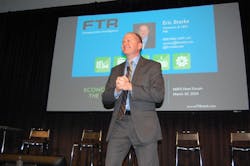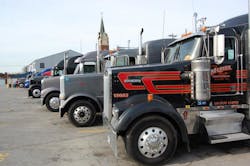LOUISVILLE, KY. When asked for his assessment of the trucking environment going forward, Eric Starks, president of FTR Transportation Intelligence that “late 2017, early 2018 could be the chokepoint” if the nation continues on its current 2 to 2 ½% GDP growth path.
That is the time, Starks said, when many new regulations, such as the electronic logging device rule, will start to hit the industry and that could start to put constraints on available drivers (the shortage could reach 120,000 by quarter three of 2018), equipment, and capacity.
Starks presented his analysis of the U.S. trucking market to attendees at the Fleet Forum on Wednesday at the Kentucky Exposition Center ahead of the Mid-America Trucking Show, here. He touched on a number of key economic indicators, but the big takeaway is that he doesn’t believe the "doomsday" prognosticators that the economy is about to turn negative.
“Does an election year really matter?” he asked. “Some of the data says no. In general, the economy does what the economy does.”
For trucking, the environment is generally looking good for the remainder of this year, he said. February saw a huge jump in the ATA Tonnage Index and FTR’s own Loadings Originated Index, while not up as much in February, is still showing steady growth.
“The trend has been typically that February is down, but February was up this year, so that is a very goDry vans could see 1.3% growth in 2016 and 2.4% in 2017 while reefers are expected to post increases of 3.2% and 3.8%, respectively.
Truck capacity is also at good levels right now, running about 95%. That will inch up to about 98% by February 2017 before that “chokepoint” could hit later in the year.
Rates are also trending up and shippers, realizing the balance between the driver shortage and potential capacity issues trucking fleets are facing, don’t seem to be pressuring fleets right now, Starks said.
On the broader economic front, Starks noted that GDP is an important indicator to watch, but it’s not the best indicator He said GDP includes a significant service sector component. A better guide is the industrial sector, which is made up primarily of freight.
That, he said, is expected to see 0% growth this year, but during the recession it was dropping 5.5%, so a flat industrial sector is actually positive news and indicative of growth.
Other indicators, such as the ISM manufacturing index, the Chicago Federal Reserve, and payrolls are all suggesting the economy is doing okay at this time. Payrolls is an important indicator, Starks said, because more people working means more people buying. Anything above 200,000 jobs created each month is positive.
“On average, we’re still holding above that 200,000 rate,” he said.
And while manufacturing indices are not producing reasons to jump for joy, “We’re not seeing things falling off the cliff,” Starks noted. Home sales and housing starts are also not suggesting any economic problems in the near future.On the negative side, though, capital goods orders are holding flat and excessive inventories are a problem.
“This tells me businesses are still a bit worried that they are not going out to buy materials,” Starks said, adding that “we need to see inventories starting to come down” to see more businesses start moving freight.
Retails sales are also a bit of a puzzle, having dipped in 2015 at a time when fuel prices dropped.
“The conventional wisdom is when fuel prices go down, people spend, [but that didn’t happen],” Starks said. While sales have leveled off, “we would like to see them start to grow.”
Auto sales are also coming off a record year in 2015 at over 17 million vehicles and Starks doesn’t see that growing, but also doesn’t see that declining significantly this year.
The good news for fleets is that Starks sees fuel prices as a “non-issue” for the next year.





